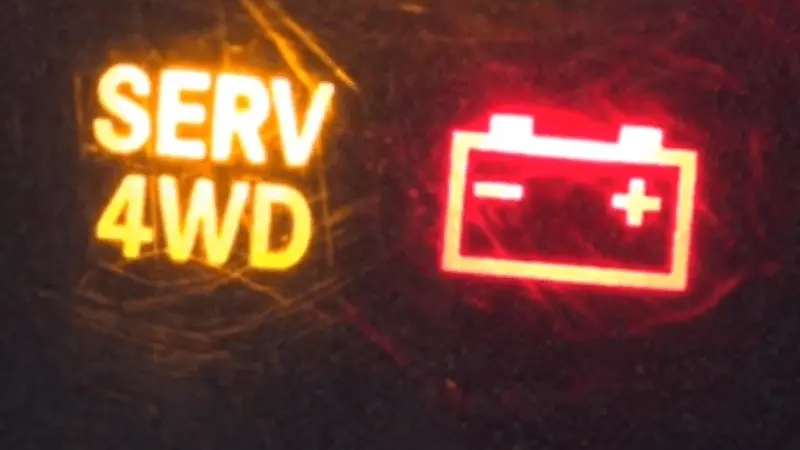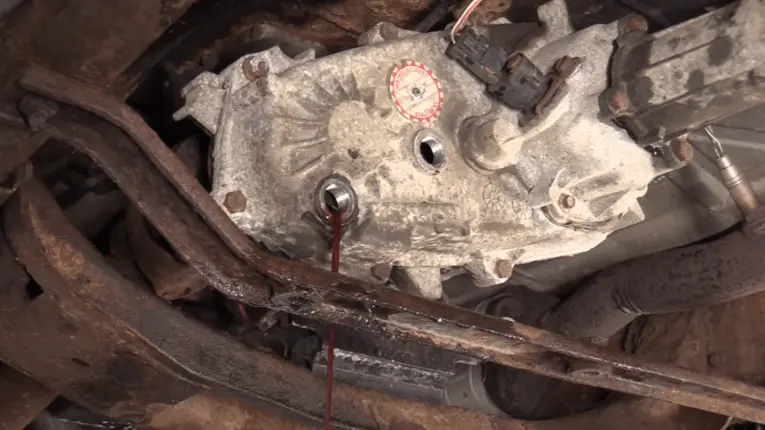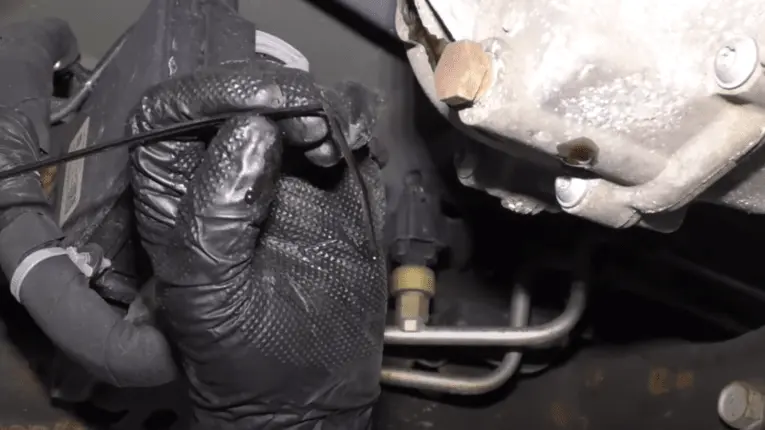The “Service 4WD” light on your vehicle’s dashboard can be a cause for concern, but it doesn’t necessarily mean you have to pull over and stop driving immediately. So, can I still drive with service 4WD light on?
Yes, you can continue driving with the “Service 4WD” light on for a short period. However, it’s not advisable for extended periods as it may pose risks to your vehicle’s drivetrain and safety. Promptly address the underlying issue to ensure safe and reliable operation.
In this blog post, we’ll delve into the potential dangers of ignoring the “Service 4WD” light and the essential steps you should take when it makes an unexpected appearance on your dashboard.
Can I Still Drive With Service 4WD Light On?

Yes, you can still drive your vehicle if the “Service 4WD” warning light is illuminated. However, it’s essential to exercise caution as driving with this warning light on may pose risks to your vehicle’s gearbox and all-wheel drive system. While it’s not an immediate emergency, it’s advisable to have your vehicle inspected as soon as possible.
Ignoring the warning light may lead to further complications and potentially expensive repairs down the road. To ensure the continued reliability and safety of your vehicle, address the underlying issue promptly by having it examined by a qualified technician.
Is It Ok To Drive With Service 4wd Light On?
Driving with the “Service 4WD” light illuminated is generally ok for a short period, but it’s not advisable for extended periods. While the vehicle may remain operable, it poses risks of reduced traction, poor handling, and potential damage to drivetrain components. Ignoring the warning light can lead to safety hazards, higher repair costs, and decreased vehicle utility. It’s recommended to have the underlying issue diagnosed and addressed by a qualified mechanic as soon as possible to ensure the proper functioning of your 4WD system, maintaining both safety and the vehicle’s value and reliability.
What Does 4WD Mean?
4WD stands for “Four Wheel Drive,” which is a drivetrain configuration found in many vehicles. In this system, power from the engine is distributed to all four wheels simultaneously. This setup offers enhanced traction and control, making it a popular choice for off-road and challenging terrain driving. While 4WD mode can consume more fuel compared to other drivetrain configurations, it provides superior performance and stability, making it a preferred choice in adverse weather conditions and off-road adventures. Depending on driving needs, vehicles may offer various drivetrain options, including front-wheel, rear-wheel, and all-wheel drive, each with its unique advantages and use cases.
What Does The “Service 4WD” Light On Your Car’s Dashboard Mean?
The “Service 4WD” warning light on your vehicle’s dashboard indicates a potential issue with your 4-wheel drive (4WD) system. There are several reasons why this warning light might illuminate, including:
1. Low Transfer Case or Differential Fluid Levels:

Regular maintenance of the transfer case and differential housing gear oil is essential to prevent system breakdowns. When these fluid levels are too low, it can lead to inadequate lubrication, increased friction, and potential damage to vital components, triggering the “Service 4WD” warning light.
2. Wheels Not Properly Aligned:
Misaligned wheels on a 4WD vehicle can render the system ineffective. Wheel misalignment may lead to unusual tire wear, reduced traction, and increased stress on drivetrain components. In some cases, an accident may have caused the misalignment, further complicating the issue.
3. Problems with Fuses:
Faulty or blown fuses in the vehicle’s fuse box can disrupt the operation of the 4WD system. If the 4WD fuse malfunctions or blows, it can trigger the “Service 4WD” warning light, as the system won’t function correctly without a properly functioning electrical circuit.
4. Electrical System Issues:
The 4WD system relies on various electrical components for its operation. Any malfunction or failure in these components, which include sensors, switches, and actuators, can lead to the “Service 4WD” light illuminating. Electrical problems may result from damaged wiring, sensor failures, or issues with the control module.
5. Mechanical Component Failures:
The 4WD system incorporates numerous mechanical components, such as driveshafts, axles, and differentials. If any of these parts become worn, damaged, or compromised due to factors like accidents or excessive wear and tear, it can lead to a decrease in the system’s effectiveness, prompting the warning light.
6. Seal Leaks:
Seals surrounding various drivetrain components, like the transfer case and differential housing, can develop leaks over time. This can be due to high temperatures, prolonged use, or deterioration. When these seals leak, it may result in insufficient lubrication and potential damage, which can trigger the “Service 4WD” warning.
Potential Dangers Of 4WD Service Light On
When the “Service 4WD” warning light illuminates on your vehicle’s dashboard, it signifies potential issues with the 4-wheel drive (4WD) system. Ignoring this warning light can lead to several dangers:

- Reduced Traction: A malfunctioning 4WD system can diminish the vehicle’s traction, especially in slippery or off-road conditions. This can make driving on wet, icy, or uneven terrain riskier and lead to loss of control.
- Poor Handling: Malfunctions in the 4WD system can result in poor handling, making the vehicle more challenging to steer, especially in adverse weather or when navigating difficult terrains.
- Drivetrain Damage: Ignoring the “Service 4WD” light can lead to further damage to drivetrain components, including the transfer case, differential, and axles. This damage may become more extensive and costly to repair over time.
- Safety Risks: In off-road or challenging driving situations, the proper functioning of the 4WD system is crucial for safety. Neglecting the warning light can pose safety risks to both the driver and passengers.
- Reduced Resale Value: Please address and repair the 4WD system to ensure the vehicle’s resale value. Prospective buyers often scrutinize the condition and functionality of the 4WD system, and a history of neglect can deter potential buyers.
- Incomplete Vehicle Utility: If the 4WD system needs to be fixed, the vehicle may not fulfill its intended purpose. This can be a significant drawback for those who rely on the 4WD capability for work or recreational activities.
- Increased Repair Costs: The longer the issue is left unattended, the more extensive the damage can become, resulting in higher repair costs. Timely maintenance and repairs are typically more cost-effective.
How Does The 4WD System Work?
A Four-Wheel Drive (4WD) system enhances a vehicle’s traction and handling by powering all four wheels simultaneously. This configuration is particularly useful for SUVs, light trucks, and all-terrain vehicles, allowing them to navigate off-road terrain and challenging weather conditions.
While the term “4WD” is often used, it’s worth noting that there’s a related but slightly distinct powertrain technology called All-Wheel Drive (AWD). AWD also distributes power to all four wheels, but it doesn’t provide the same level of control and traction as a dedicated 4WD system. Both AWD and 4WD systems have their place, especially for drivers tackling rough roads and diverse terrains.
In a 4WD system, torque is sent to each wheel, although the way this is achieved can vary between different vehicles. Some 4WD systems employ a locking differential to ensure that each of the four wheels receives an equal amount of torque. In contrast, others use an open differential, allowing wheels to spin at different rates, especially when cornering.
Most 4WD systems incorporate a transfer case, which is responsible for transferring power from the vehicle’s gearbox to the powertrain and directing it to any of the four wheels as needed.
How To Reset 4WD Service Light On Silverado?
Solving the Silverado “Service 4WD” light issue involves several steps to diagnose and address the underlying problem. Here’s a general guide on how to tackle this issue:
Consult Your Owner’s Manual:
Begin by referring to your vehicle’s owner’s manual to understand the meaning of the “Service 4WD” light and to check if the manufacturer recommends specific troubleshooting steps.
Check the 4WD System:
Verify the functionality of your 4WD system by attempting to engage and disengage different 4WD modes. Pay attention to any unusual sounds, indicator lights, or handling issues.
Inspect for Visible Issues:
Examine the physical components of the 4WD system, including switches, wires, and connectors, for signs of damage, wear, or loose connections. Ensure that the system is free from debris or obstructions.
RELATED: Common Chevy 4 Wheel Drive Switch Problems
Check Fluid Levels:

Inspect the transfer case and differential fluid levels. Low or contaminated fluid can affect the system’s operation. If necessary, top up or replace the fluids according to your vehicle’s maintenance schedule.
Scan for Error Codes:
Use a diagnostic scanner to retrieve error codes from the vehicle’s onboard computer. These codes can provide insights into the specific issue triggering the warning light.
Consult a Mechanic:
If you’re unable to identify or address the problem yourself, it’s advisable to take your vehicle to a qualified mechanic or dealership. They have the expertise and tools to diagnose and repair the issue correctly.
Follow Maintenance Schedule:
To prevent future “Service 4WD” light issues, adhere to your vehicle’s recommended maintenance schedule, which typically includes regular checks and servicing of the 4WD system.
Clear the Warning Light:
Once the issue is resolved, the mechanic can clear the warning light from the vehicle’s computer system. It’s essential to ensure that the problem is addressed before clearing the light.
Frequently Asked Questions
1. Can the “Service 4WD” Light Be Reset or Cleared?
The “Service 4WD” light can often be reset or cleared from the vehicle’s computer system once the underlying issue has been addressed. A qualified mechanic typically does this during the repair process.
2. Are There Temporary Fixes for the “Service 4WD” Light?
While some issues triggering the warning light may be temporary, attempting to address them without professional diagnosis and repairs can be risky. It’s advisable to have the problem properly diagnosed and fixed to prevent potential safety hazards.
3. Does the “Service 4WD” Light Affect Fuel Efficiency?
Depending on the issue causing the light to illuminate, there might be some impact on fuel efficiency. For example, drivetrain components that are not functioning correctly can result in increased friction and reduced efficiency.
4. Can I Drive My Vehicle in 2WD Mode When the “Service 4WD” Light Is On?
In many cases, you can still drive your vehicle in 2WD mode when the “Service 4WD” light is on. This is often considered safe for regular driving, but it’s essential to address the issue promptly to restore the full functionality of the 4WD system.
5. How Can I Prevent “Service 4WD” Light Issues in the Future?
Regular adherence to your vehicle’s maintenance schedule, including servicing the 4WD system, checking fluid levels, and inspecting for visible damage, can help prevent future “Service 4WD” light issues. Timely maintenance and attention to any early warning signs can go a long way in maintaining the system’s reliability.
Bottom Line
In the end, it’s important to address the “Service 4WD” light issue promptly. While you can continue driving for a short duration, ignoring the warning light can lead to reduced traction, handling problems, and potential damage to drivetrain components. It’s crucial to have the underlying problem diagnosed and repaired by a qualified mechanic as soon as possible.
Taking these steps will not only ensure the safe and efficient operation of your 4WD system but also prevent potential dangers, increased repair costs, and diminished vehicle utility. Your vehicle’s performance and your peace of mind are worth the attention and maintenance it deserves.

Eric L. Friedman is a car expert who has worked on Chevy and GMC trucks for over 10 years. He started AutoYolo to help people fix their own cars. On the blog, he shares easy tips, step-by-step guides, and repair advice to make car problems less stressful and more affordable.

